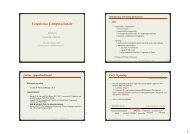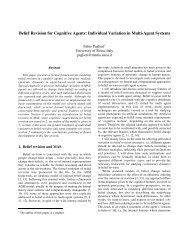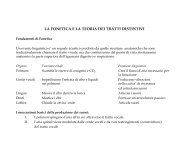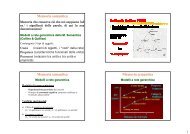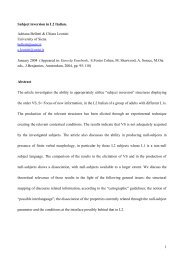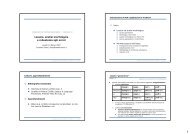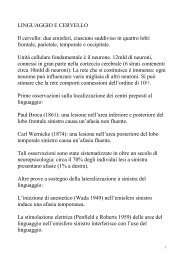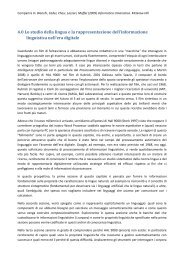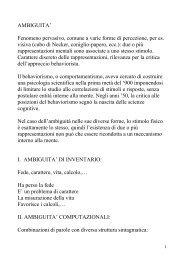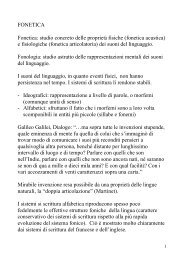Verbal morphology in Greek: the 'passive'
Verbal morphology in Greek: the 'passive'
Verbal morphology in Greek: the 'passive'
You also want an ePaper? Increase the reach of your titles
YUMPU automatically turns print PDFs into web optimized ePapers that Google loves.
. (To filo) peft-i<br />
<strong>the</strong> leaf fall-3p<br />
“The leaf/it falls.”<br />
c. Vrex-i.<br />
ra<strong>in</strong>-3S<br />
“It ra<strong>in</strong>s.”<br />
(29) Active voice <strong>in</strong>flections<br />
3<br />
<br />
plen<br />
D (=EPP)<br />
o/-is/-i/ etc.<br />
If a DP/clitic is present, <strong>the</strong>n it forms a cha<strong>in</strong> with D. The morphological structure builds on<br />
<strong>the</strong> same D category as syntax (so <strong>morphology</strong> and syntax are unified).<br />
Active person <strong>in</strong>flections nom<strong>in</strong>ative case.<br />
NACT <strong>in</strong>flections, on <strong>the</strong> o<strong>the</strong>r hand, exclude <strong>the</strong> external argument and consistently pick<br />
up <strong>the</strong> <strong>in</strong>ternal argument, thus resembl<strong>in</strong>g participial <strong>in</strong>flection <strong>in</strong> Romance, cf. Italian<br />
mangiat-a/-i (eaten-FEM.SG/PL) or arrivat-a/-i (arrived-FEM.SG/PL) (Burzio 1986)<br />
NACT <strong>in</strong>flections absolutive case.<br />
(30) a. (Ta pedhjia) plenonde.<br />
<strong>the</strong> children wash-NACT.3p<br />
“The children are be<strong>in</strong>g washed/ The children wash (<strong>the</strong>mselves).”<br />
b. (To aftok<strong>in</strong>ito) plenete.<br />
<strong>the</strong> car wash-NACT.3s<br />
“The car is be<strong>in</strong>g washed.”<br />
In (a): most salient read<strong>in</strong>gs = passive, reflexive; <strong>in</strong> (b): passive.<br />
The <strong>in</strong>ternal argument is „promoted‟ to <strong>the</strong> EPP position; see standard generative approaches.<br />
(31) a. Active b. Non-active<br />
3 3<br />
D D<br />
plen (x,y) o (x) plen (x,y) (o)me (y)<br />
In (a): <strong>the</strong> unassociated <strong>in</strong>ternal argument receives a syntactic realization. In (b): <strong>the</strong><br />
unassociated external argument is open to a number of options: i) rema<strong>in</strong> unrealized and be<br />
existentially bound, ii) form a cha<strong>in</strong> with a DP <strong>in</strong>side <strong>the</strong> by-phrase (both give rise to a<br />
passive read<strong>in</strong>g), iii) associate with <strong>the</strong> EPP argument (<strong>the</strong> reflexive read<strong>in</strong>g), or iv) receive<br />
no <strong>in</strong>terpretation (no Agent implied; <strong>the</strong> anticausative read<strong>in</strong>g). In <strong>the</strong> absence of any<br />
additional syntactic <strong>in</strong>formation all three read<strong>in</strong>gs are resolved at LF (along with <strong>the</strong> lexical<br />
properties of <strong>the</strong> predicates <strong>in</strong>volved; see partly Tsimpli 2005).<br />
<br />
Albanian has one fur<strong>the</strong>r read<strong>in</strong>g: <strong>the</strong> impersonal (see (25) and (26) above). NACT<br />
<strong>morphology</strong> can attach to unergative verbs (compatible with <strong>the</strong> idea that <strong>the</strong>y are<br />
„hidden‟ transitives, Hale & Keyser 1993). It can also attach to unaccusatives: <strong>the</strong>ir only<br />
argument is <strong>the</strong> <strong>the</strong>me; thus <strong>the</strong> passive read<strong>in</strong>g is excluded, and <strong>the</strong> impersonal is <strong>the</strong><br />
10




